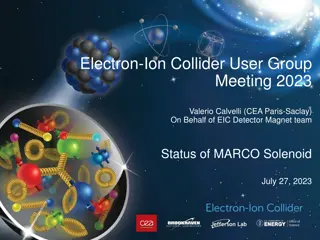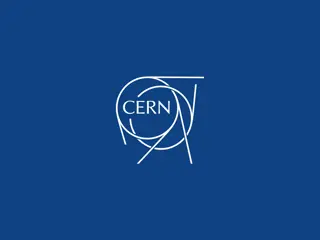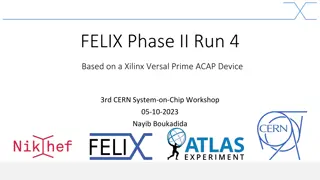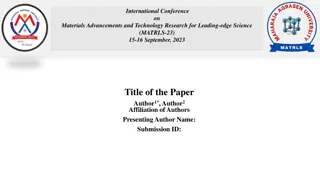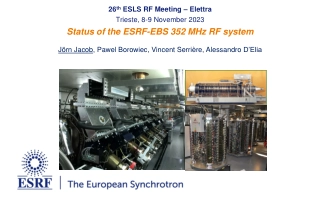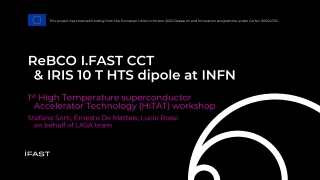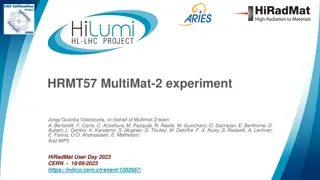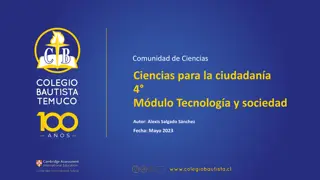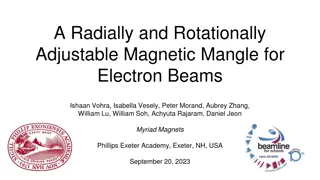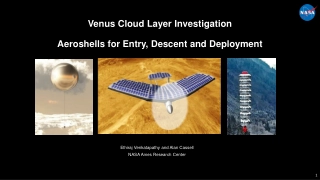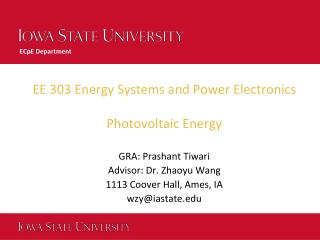Advancements in Superconducting Solenoid Technology for Klystrons at CERN
Research highlights the first operation of a klystron equipped with a superconducting MgB2 solenoid, aiming to enhance efficiency and sustainability of klystron systems. The focus is on integrating novel solenoid designs, such as those proposed by A. Yamamoto, to optimize klystron performance at CERN. Various factors affecting efficiency, such as electron beam confinement and electromagnetic field enhancements, are discussed. The application of superconducting magnet technology and innovative solenoid designs showcase promising developments in particle accelerator RF systems.
Advancements in Superconducting Solenoid Technology for Klystrons at CERN
PowerPoint presentation about 'Advancements in Superconducting Solenoid Technology for Klystrons at CERN'. This presentation describes the topic on Research highlights the first operation of a klystron equipped with a superconducting MgB2 solenoid, aiming to enhance efficiency and sustainability of klystron systems. The focus is on integrating novel solenoid designs, such as those proposed by A. Yamamoto, to optimize klystron performance at CERN. Various factors affecting efficiency, such as electron beam confinement and electromagnetic field enhancements, are discussed. The application of superconducting magnet technology and innovative solenoid designs showcase promising developments in particle accelerator RF systems.. Download this presentation absolutely free.
Presentation Transcript
FIRST OPERATION OF A KLYSTRON FITTED WITH A SUPERCONDUCTING MGB2 SOLENOID N.CATALAN-LASHERAS, M.BORONAT, G.MCMONAGLE, I. SYRATCHEV, CERN A.BAIG, A. CASTILLA-LOEZA, COCKCROFT INSTITUTE T.KIMURA, P. KOLDA, COMMUNICATION & POWER INDUSTRIES S.MICHIZONO , A.YAMAMOTO, KEK
OUTLOOK Motivation Cable and magnet manufacturing Integration at CERN Performance of the klystron system Conclusions 1
FCC, 1.2MW New projects are rated by their efficiency and sustainability performance Recent years have seen tremendous effort to make more efficient klystrons Among effects studied: E field expansion in the drift tubes; Ohmic loses; Space charge depression; Bunch saturation; Bunch congregation; Bunch stratification; Radial bunch expansion; Reflected electrons. MOTIVATION J. Cai and I. Syratchev, "Design Study of X-band High Efficiency Klystrons for CLIC," 2020 IEEE 21st International Conference on Vacuum Electronics (IVEC), 2020, pp. 121-122, doi: 10.1109/IVEC45766.2020.9520585. 2
SOLENOID FOR PULSED KLYSTRONS Solenoidal field needed to confine the electron beam in the klystron channel. Electromagnet sits at constant current even for pulsed klystrons with low duty cycle In the x-band facility consumption of the electromagnet represents ~30% of the total power source AC power/RF efficiency = 15.2% AC power/RF efficiency = 15.2% ` 3
SOLENOID FOR PULSED KLYSTRONS Solenoidal field needed to confine the electron beam in the klystron channel. Electromagnet sits at constant current even for pulsed klystrons with low duty cycle In the x-band facility consumption of the electromagnet represents ~30% of the total power source With a gain in klystron efficiency from 40% to 65% and an optimized pulse we can save 20 KW per RF unit AC power/RF efficiency = 21 AC power/RF efficiency = 21 .0% .0% The solenoid will then represent 37% of the power` 4
Proposal from A. Yamamoto (KEK) to build a superconducting solenoid that could be tested and operational on the CERN X-band facility SOLENOID DESIGN AND CHARACTERISTICS The required magnetic field is well below 1T so we can use MgB2 working below 30 K to improve the cryocooler efficiency ad minimize costs A. Yamamoto et al., Applying Superconducting Magnet Technology for High-Efficiency Klystrons in Particle Accelerator RF Systems , IEEE Transactions on Applied Superconductivity, vol. 30, no. 4, pp. 1- 4, Jun. 2020.doi:10.1109/TASC.2020.2978471 5
8km MgB2 wire (0,67 mm) manufactured by Hitachi. Based on experience for MRI magnets CABLE AND CABLE 21 samples measured. Very good homogeneity TESTS Critical temperature of the cable at the operational point is 29 K. 57.1 A and 1.06 T field in the coil Works at 46% of the load-line H. Tanaka et al., Performance of MgB2 Superconductor Developed for High-Efficiency Klystron Applications , IEEE Transactions on Applied Superconductivity, vol. 30, no. 4, pp. 1-5, Jun. 2020. doi:10.1109/TASC.2020.2970391 6
MANUFACTURING OF THE SC SOLENOID IN HITACHI Wind and react coils (2) in an iron cryostat that serves also as return yoke. Passive quench protection Superconductor MgB2 Maximum B field 0.8 T Current 57.1 A Inductance 7.3 H Max. field in coil 1.06 T Operating temperature <20 K Stored energy 11.8 kJ Weight 600 Kg AC plug power <3 kW 7
Quench tests. Self protected 10-hours excitation tests Power abort test Magnetic field measurements Very good agreement FIRST TESTS AT HITACHI H. WATANABE ET AL., DEVELOPMENT OF PROTOTYPE MGB2 SUPERCONDUCTING SOLENOID MAGNET FOR HIGH-EFFICIENCY KLYSTRON APPLICATIONS , IEEE TRANSACTIONS ON APPLIED SUPERCONDUCTIVITY, VOL. 30, NO. 4, PP. 1-6, JUN. 2020. DOI:10.1109/TASC.2020.297223 8
COOL-DOWN Two twin coils cooled by conduction. Insulation vacuum Helium only on the cryocooler/cold head Air cooled-compressor Cryocooler plus cold head Available instrumentation: Temperature sensors. Thermo- couples and PtCo sensors Voltage taps Heaters (not used at CERN) 9
MAGNETIC MEASUREMENTS Measurements done with a hall probe Homogeneity and reproducibility are very good! Small difference between magnets at the level of fringe fields Close to the cathode where beam rigidity is smaller. Probably important for performance 10
INSTALLATION IN THE KLYSTRON Full compatibility with klystron and modulator interfaces Larger volume required on the side of modulator Special care needed with handling as the load is asymmetric Vacuum pump permanently connected (insulation vacuum) 11
From two to three feeds (current current, cooling cooling, vacuum) INTERLOCKS AND SAFETY Interlocks on vacuum and temperature to protect the solenoid Interlock on solenoid current to protect the klystron 12
FIRST MEASUREMENTS Measurements could not be done at nominal conditions as load not conditioned to full power Max power ~20 MW Originally optimized at CPI for nominal power @ 50 MW Current adjusted for central field. Nominal counter-coil settings for NC solenoid SC gain curve shows higher gain and faster saturation Counter-coil current adjusted for smaller beam to match original gain 13
RE-TUNING OF THE COUNTER- COIL Counter-coil re-tuned by an additional 20% in current to recover performance Same correction is valid for every klystron gain Counter-coil current settings are valid for all set-points 14
CONCLUSIONS SC technology can be applied to klystron solenoid Energy consumption reduced by 90% 20 -> <3 kW. Further reductions still possible Magnetic field very similar to the conventional magnet No interception Some adjustments needed to recover performance inside the tuning range of the power supply Large operational margin makes it very stable and robust against failures AC power/RF efficiency = 21% AC power/RF efficiency = 21% 15
CONCLUSIONS SC technology can be applied to klystron solenoid Energy consumption reduced by 90% 20 -> <3 kW. Further reductions still possible Magnetic field very similar to the conventional magnet No interception Some adjustments needed to recover performance inside the tuning range of the power supply Large operational margin makes it very stable and robust against failures AC power/RF efficiency = 31.7% AC power/RF efficiency = 31.7% With a high efficiency klystron , modulator AND a SC solenoid we will save >50% of the power for the same output RF power! 16



